 Website:
Zimed Medical
Website:
Zimed Medical
Catalog excerpts

PELVIC& ACETABULUM PLATE SYSTEM SURGICAL TECHNIQUE
Open the catalog to page 1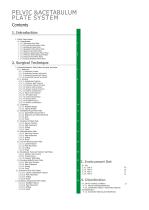
PELVIC &ACETABULUM P L AT E S Y S T E M Contents 1. Introduction 1.1.Pelvic Plate System 1.1.1.Specification 1.1.1.1.Reconstruct on Plate 1.1.1.2.Curved Reconstruct on Plate 1.1.1.3.Acetabular Hook Plate 1.1.1.4.Symph s s Pub s Pelv c Plate 1.1.1.5.Super or Sacro l ac Plate 1.1.1.6.Anter or Il opect neal Pelv c Plate 1.1.1.7.Poster or Wall Acetabular Plates 1.1.1.8.Anter or Br m Pelv c Plate 1.1.1.9.Lock ng Butterfly Pelv c Plate 2. Surgical Technique 2.1.Pelvic&Acetabulum Plate System Surgical Technique 2.1.1. Reduction 2.1.1.1. Reduct on Forceps 2.1.1.2. Reduct on forceps w th po nts...
Open the catalog to page 2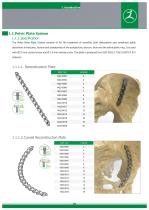
1.1.Pelvic Plate System 1.1.1.Specification The Pelvis Bone Plate System consists of for the treatment of sacroiliac joint dislocations and symphysis pubis distortions in fractures, fusions and osteotomies of the acetabulum, sacrum, ilium and the entire pelvic ring. It is used with Ø3.5 mm cortical screw and Ø 3.5 mm locking screw. The plate is produced from ISO 5832-2 TiGr3 (ASTM F 67) material.
Open the catalog to page 3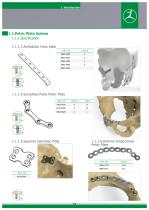
1.1.Pelvic Plate System 1.1.1.Specification 1.1.1.3.Acetabular hook plate HOLES 1.1.1.4.Symphisis Pubis Pelvic Plate REF. NO 1.1.1.6.Anterior Iliopectineal Pelvic Plate
Open the catalog to page 4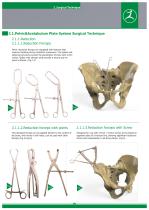
2.1.Pelvic&Acetabulum Plate System Surgical Technique 2.1.1.Reduction 2.1.1.1.Reduction Forceps Pelvic reduction forceps are equipped with features that improve handling during reduction maneuvers. The spikes and spherical structure prevent the penetration of bone with a thin cortex. Spikes with sharper ends provide a secure grip on pelvic surfaces. (F g.1-2) 2.1.1.2.Reduction forceps with points This standard forceps can be applied directly to the surface of the bone, with hooks in drill holes, can be used with other forceps (F g.3).(F g.5). 2.1.1.3.Reduction forceps with Screw Designed...
Open the catalog to page 5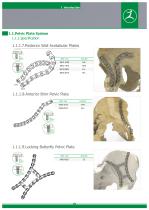
1.1.1.7.Posterior Wall Acetabular Plates Ø3.5 Cortical Screw 1.1.1.8.Anterior Brim Pelvic Plate REF. NO 1.1.1.9.Locking Butterfly Pelvic Plate REF. NO Ø3.5 Cortical Screw
Open the catalog to page 6
2.1.Pelvic Plate System Surgical Technique 2.1.1.Reduction 2.1.1.4.Pointed ball tip and round disk Flat ball spikes make it easy to reduce bone fragments. They have a pointed tip and a thin cortex to reduce the risk of the tool slipping through the bone, and a pointed ball point to prevent penetration of the bone. (F g.5) Discs can be used with pointed ball reduction forceps or pointed ball type instruments. They can help distribute applied forces over a larger surface area to prevent iatrogenic or compression fractures in poor quality bone (osteoporotic), (F g.6).
Open the catalog to page 7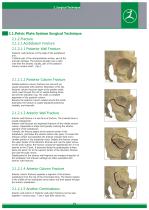
2.1.Pelvic Plate System Surgical Technique 2.1.2.Fracture 2.1.2.1.Acetabulum Fracture 2.1.2.1.1 Posterior Wall Fracture Posterior wall fractures cut the edge of the acetabulum and It affects part of the retroacetabular surface, part of the articular cartilage. The fracture spreads over a wider area than the severity. Usually, part of the posterior column remains intact. (F g.1) 2.1.2.1.2 Posterior Column Fracture Isolated posterior column fractures are rare and are usually associated with posterior dislocation of the hip. Posterior column fractures begin at the greater sciatic notch, pass...
Open the catalog to page 8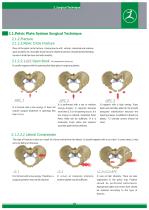
2.1.Pelvic Plate System Surgical Technique 2.1.2.Fracture 2.1.2.2.Pelvic Circle Fracture Many of the pelvic circle fracture is being due to with vehicle , industrial and extreme sport accident etc. Normally those fracture related excessive retroperitoneal bleeding trauma in firsth few hour end with moratily. It usually happens with the opening that takes place in engine accidents. It is performed with a low or medium It happens with a high energy. Pupic It is formed with a low energy. It does not energy.-Surgery is required because plate and sacroiliac plate do not provide require surgical...
Open the catalog to page 9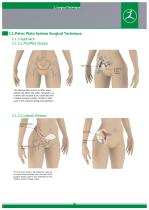
2.1.Pelvic Plate System Surgical Technique 2.1.3.Approach 2.1.3.2.Modified Stoppa Pelv c Br m Super or pub c ramus The Pfannenstiel incision is often used placed just above the pubic symphysis, as it allows the incision to be combined with a lateral window incision, similar to that used in the classical ilioinguinal approach. 2.1.3.3.Lateral Window Glutesu med us p llar İl ac crest If more areas need to be looked at, make an arcuate incision starting from the back of the gluteus medius column and extending to the midline incision already made.
Open the catalog to page 10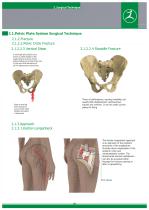
2.1.Pelvic Plate System Surgical Technique 2.1.2.Fracture 2.1.2.2.Pelvic Circle Fracture 2.1.2.2.4 Straddle Fracture 2.1.2.2.3 Vertical Shear A vert cally d rected force or forces at r ght angles to the support ng structures of the pelv s lead ng to vert cal fractures n the ram and d srupt on of all the l gamentous structures. There is birefringence, causing instability, but usually little displacement. Genitourinary injuries are common. İt can be useful curved plates for fixing h gh on one leg from d stances occurs w th a fall. Breaks and spl ts s observed. The Kocher-Langenbeck approach is...
Open the catalog to page 11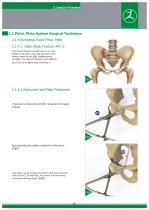
2.1.Pelvic Plate System Surgical Technique 2.1.4.Symphisis Pupis Pelvic Plate 2.1.4.1. Open-Book Fracture APC-2 This type of fracture usually has two or more breaks in the pelvic ring, and the ends of the broken bones do not align (displacement) correctly. This type of fracture is more likely to occur due to a high-energy event(Fig.7). Fracture s reduced w th (B1 reduct on forceps) (F g.8) Appropr ate s ze plate s placed on the area. (F g9) (The plate can be temporar ly fixed to the bone w th the help of the C7 Po nted ball. To prevent t from mov ng dur ng the dr ll ng phase) (F g9)
Open the catalog to page 12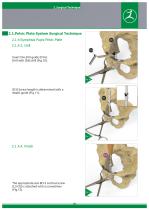
2.1.Pelvic Plate System Surgical Technique 2.1.4.Symphisis Pupis Pelvic Plate (D3) Screw length s determ ned w th a depth gu de (F g.11). D3 The appropr ate s ze Ø3.5 cort cal screw (C3-C8) s attached w th a screwdr ver (F g.12). F g.12
Open the catalog to page 13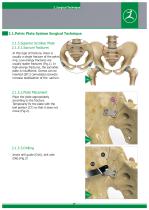
2.1.Pelvic Plate System Surgical Technique 2.1.5.Superior Scroiliac Plate 2.1.5.1.Sacrum fractures In this type of fracture, there is usually a single fracture of the pelvic ring. Low-energy fractures are usually stable fractures (Fig.1). In high-energy fractures, the sacroiliac plate is insufficient. Screws can be inserted (Ø7.3 cannulated screw)to increase stabilization of the sacrum. 2.1.5.2.Plate Placement Place the plate appropriately according to the fracture. Temporarily fix the plate with the ball pointer (C7) so that it does not move (Fig.2). 2.1.5.3.Drilling Insert drill guide (D16)....
Open the catalog to page 14All Zimed Medical catalogs and technical brochures
-
product catalog
66 Pages





